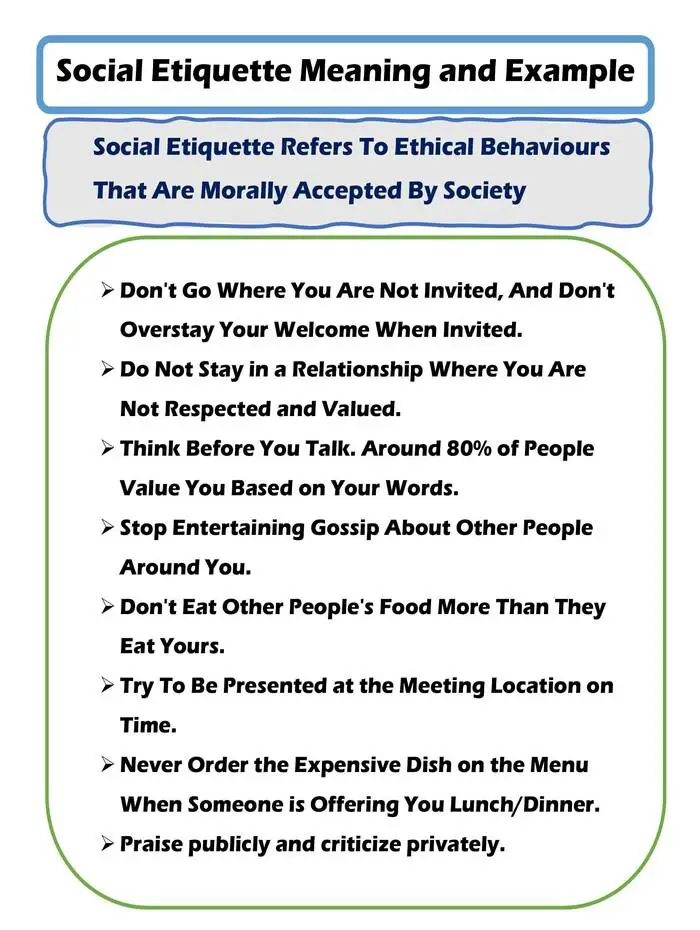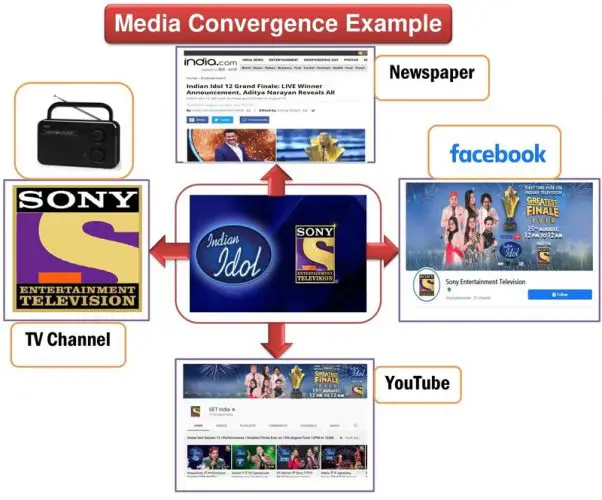Social Etiquette Meaning and Example. Definition and Examples of Social Media Etiquette.
Social Etiquette Meaning
Social etiquette refers to the ethical behaviors of human beings that are morally accepted by society. It is also known as social norms. The alternative names of social etiquette are the social norm, social manner, and unwritten social rule. Social etiquette can differ from society to society based on the environment of the community. For example, some etiquettes are admissible in society; however, the same etiquettes are offensive to another society. So, social etiquette is followed differently in different social groups. People should not indulge in unethical behavior and activity.

Social Etiquette Meaning and Example
The author has presented the definition of social etiquette and some examples of social etiquette from many viewpoints of life. You will get ideas on how to avoid unethical behavior and misuse of social media sites. The social etiquette meaning and example might assist students, employees, and social media users in behaving properly.
Social Etiquette Examples
Don’t Go Where You Are Not Invited, And Don’t Overstay Your Welcome When Invited.
Do Not Stay in a Relationship Where You Are Not Respected and Valued.
Think Before You Talk. Around 80% of People Value You Based on Your Words.
Stop Entertaining Gossip About Other People Around You.
You Should Reduce Visiting Other People, Especially If They Don’t Visit You as Well.
Don’t Eat Other People’s Food More Than They Eat Yours.
Use Both Verbal and Nonverbal Communication Cues While Speaking To Others.
Try To Be Presented at the Meeting Location On Time.
Examples of Social Etiquette
Don’t call someone more than twice continuously. If they don’t pick up your call, presume they have something important to attend to.
Return money you borrowed even before the person you borrowed you remembers or asks for it. It shows your integrity and character. The same goes for umbrellas, pens, and lunch boxes.
Never order the expensive dish on the menu when someone is giving you lunch/dinner.
Don’t ask awkward questions like, ‘Oh, so you aren’t married yet?’ Or ‘Don’t you have kids’ or ‘Why didn’t you buy a house?’ Or why don’t you buy a car? For God’s sake, it isn’t your problem;
Always open the door for the person coming behind you. It doesn’t matter if it is a guy or a girl, senior or junior. You don’t grow small by treating someone well in public;
If you take a taxi with a friend and they pay now, try paying next time;
Respect different shades of opinions. Remember, what’s 6 to you will appear 9 to someone facing you. Besides, a second opinion is good for an alternative;
Never interrupt people talking. Allow them to pour it out. As they say, hear them all and filter them all;
If you tease someone and don’t seem to enjoy it, stop it and never do it again. It encourages one to do more, and it shows how appreciative you are;
Say “Thank you” when someone is helping you.
Social Etiquette Examples
Praise publicly and criticize privately.
There’s rarely a reason to comment on someone’s weight. Just say, “You look fantastic.” If they want to talk about losing weight, they will;
Don’t swipe left or right when someone shows you a photo on their phone. You never know what’s next;
If a colleague tells you they have a doctor’s appointment, don’t ask what it’s for; say, “I hope you’re okay.” Please don’t put them in the uncomfortable position of having to tell you about their illness. If they want you to know, they’ll do so without your inquisitiveness;
Treat the cleaner with the same respect as the CEO. Nobody is impressed at how rude you can treat someone below you, but people will notice if you treat them with respect;
If a person is speaking directly to you, staring at your phone is rude;
Never advise until you’re asked;
When meeting someone after a long time, unless they want to talk about it, don’t ask them their age and salary;
Mind your business unless anything involves you directly – stay out of it;
Remove your sunglasses if you are talking to anyone in the street. It is a sign of respect. Moreso, eye contact is as important as your speech; and
Never talk about your riches among others. Similarly, don’t talk about your children in the midst of the barren.
After reading a good message, try to say, “Thanks for the message.”
APPRECIATION remains the easiest way of getting what you don’t have.
These are the basic Social Norms and Etiquette that everyone must follow in society.
Social Media Etiquette Definition
Social media etiquette refers to the ethical use of social media to communicate with other people and spread authentic information. Many people use social media to share fake and fabricated unethical information. People are not maintaining social media etiquette. They indulge in spreading fake news on social media platforms. Social media etiquette sets rules and regulations for users to optimize these sites positively. It also stops social media misuse.
Social Media Etiquette Examples
Do Not Trust Everything You View On Social Media Platforms.
When you are happy with someone in private, you don’t need to prove it on social media!!
Try to attribute the authentic person when you use someone’s caption for Facebook, Instagram, and Instagram.
Try to avoid liking your post, photo, and video.
Don’t post or tag photos of fans, customers, or employees without permission.
Don’t tag people or pages that aren’t relevant to your post.
Try to avoid asking others for likes, comments, or shares of your post.
Do not share the victim’s photos on social media sites.
